
Defining disability in the modern world goes beyond just a medical diagnosis. It’s a complex interplay between three factors; impairment, activity limitations and participation restriction.
Impairment refers to a limitation in a person’s body structure or function, or in mental functioning. Examples of this can include vision loss, hearing loss, difficulty walking, or learning challenges.
Activity limitation describes the difficulty a person has performing specific activities due to their impairment. For instance, someone with vision loss might struggle to read a book.
Participation restrictions refer to the barriers a person faces when trying to fully engage in society because of their impairment and activity limitations. Imagine someone who uses a wheelchair but can’t access public buildings due to a lack of ramps.
The modern understanding of disability emphasizes the social model. This model views disability as caused not just by the impairment itself, but also by environmental and societal barriers. But what does this actually mean?
A person with a visual impairment isn’t “disabled” because they can’t see. They become disabled if the world around them isn’t accessible, lacking things like braille signs or audio descriptions. The focus shifts to removing these barriers through ramps, clear communication, and assistive technologies. This approach aims to create a more inclusive world where everyone can participate equally, regardless of their impairments. The social model pushes for creating a more inclusive world by removing these barriers. This can involve installing ramps, providing clear communication tools (like sign language interpreters), and promoting assistive technologies.
All of this stems back to the disability rights movement. The disability rights movement has played a crucial role in advocating for equal opportunities and challenging discrimination. Because of this movement, there’s a growing push for greater representation of people with disabilities in media, education, and workplaces, ultimately helping to combat stereotypes and fosters a more understanding society.
Modern disability emphasizes creating a more inclusive world where everyone can participate equally, regardless of their impairments. It’s about recognizing that disability is not a limitation inherent to the person, but rather a result of societal structures that haven’t yet adapted to accommodate diverse abilities.










